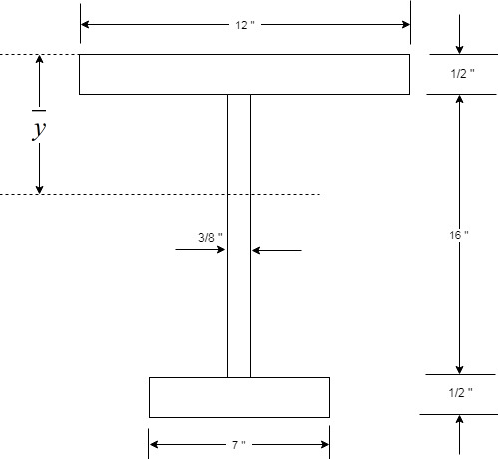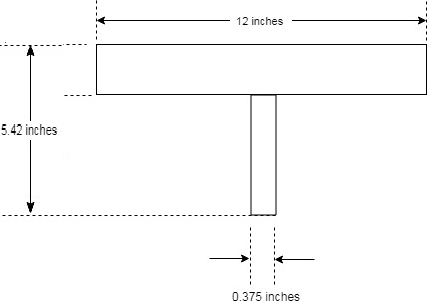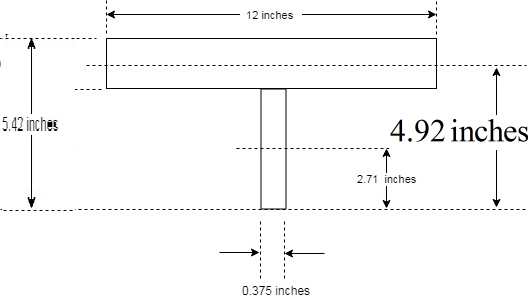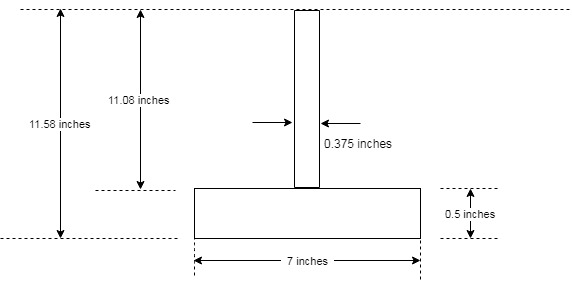
(a)
The distance
Answer to Problem 5.2.2P
Explanation of Solution
Given:
An unsymmetrical flexural member consists of a

Concept Used:
As the given flexural member is unsymmetrical, therefore, the plastic neutral axis of the section won’t lie on the center of the member.
We will use the concept of equilibrium of forces, to calculate the distance
Calculation:
Now, as we have the following equation
Where,
As the force is equal, we have
Now, calculating the area of the top flange, as follows:
Substituting the values, we have
Calculating the area of the web above the neutral axis, as follows:
Substituting the values, we have
Now, calculating the area of component above the plastic neutral axis as follows:
Now, calculating the area of the bottom flange, we have
Substitute the
Calculating the area of the web below the neutral axis, as follows:
Substituting the values, we have
Calculating the area of the component below the plastic neutral axis as follows:
Now for computing the neutral axis, use
Substitute the values, we have
Conclusion:
Therefore, the distance
(b)
Plastic moment MPfor the horizontal plastic neutral axis.
Answer to Problem 5.2.2P
Explanation of Solution
Given:
An unsymmetrical flexural member consists of a
Calculation:
We have the following formula for the plastic moment of the section
Where,
And we have following formula for calculating the plastic section modulus
We have,
As we have calculated, the distance
We now have the following diagram to consider:

Calculate the area of the top flange as follows:
Now, the area of the web portion that is left is as follows:
Now, calculating the centroidal distance of the web as follows:
Now, calculating the centroidal distance of the top flange as follows:

Following figure shows the centroidal distances that were found in the above steps.
Calculating
| Member Component | |||
| Web | |||
| Top Flange | |||
| Total |
Now calculating the value of
Now, similarly find for the lower half section, we have the following figure

Calculate the area of the bottom flange as follows:
Now, the area of the web portion that is left is as follows:
Now, calculating the centroidal distance of the web as follows:
Now, calculating the centroidal distance of the bottom flange as follows:
Calculating
| Member Component | |||
| Web | |||
| Top Flange | |||
| Total |
Now calculating the value of
Now, calculating the plastic section modulus as follows:
Substituting the values, we have
And
Now, for the plastic moment of the section, we have
Substituting the values
Conclusion:
Therefore, the plastic moment MP for the horizontal plastic neutral axis is
(c)
The plastic section modulus Z with respect to the minor principal axis.
Answer to Problem 5.2.2P
Explanation of Solution
Given:
An unsymmetrical flexural member consists of a
Calculation:
To find thePlastic section modulus Z with respect to the minor principal axis, we need to know that the vertical line or axis is considered to be the minor principal axis, therefore as we know that the member is symmetrical along the y-axis, and the same axis is the minor principal axis which confirms that the plastic neutral axis is passing through its center.
We have the following formula for the plastic section modulus:
Where,
and A is the total area of cross section.
Now, as we know that the plastic neutral axis is passing through the center of the minor principal axis, we conclude
And know we need to find any one of them and let that be equal to
Thus, we have
We can find the
| Member Component | |||
| Top Flange | |||
| Web | |||
| Bottom Flange | |||
| Total |
Calculating the centroidal distance as follows:
Calculation of plastic section modulus is as follows:
Substituting the values, we have
Conclusion:
Therefore, the value of plastic section modulus Z with respect to the minor principal axis is
Want to see more full solutions like this?
Chapter 5 Solutions
Steel Design (Activate Learning with these NEW titles from Engineering!)
- 6. A lake with no outlet is fed by a river with a constant flow of 1200 ft3/s. Water evaporates from the surface at a constant rate of 13 ft3/s per square mile of surface area. The surface area varies with the depth h (in feet) as A (square miles) = 4.5 + 5.5h. What is the equilibrium depth of the lake? Below what river discharge (volume flow rate) will the lake dry up?arrow_forwardProblem 5 (A, B, C and D are fixed). Find the reactions at A and D 8 k B 15 ft A -20 ft C 10 ft Darrow_forwardProblem 4 (A, B, E, D and F are all pin connected and C is fixed) Find the reactions at A, D and F 8 m B 6m E 12 kN D F 4 marrow_forward
- Problem 1 (A, C and D are pins) Find the reactions and A, C and D. D 6 m B 12 kN/m 8 m A C 6 marrow_forwardUniform Grade of Pipe Station of Point A is 9+50.00. Elevation Point A = 250.75.Station of Point B is 13+75.00. Elevation Point B = 244.10 1) Calculate flowline of pipe elevations at every 50 ft. interval (Half Station). 2) Tabulate station and elevation for each station like shown on example 3) Draw Sketcharrow_forward40m 150N B 40marrow_forward
- Note: Please accurately answer it!. I'll give it a thumbs up or down based on the answer quality and precision. Question: What is the group name of Sample B in problem 3 from the image?. By also using the ASTM flow chart!. This unit is soil mechanics btwarrow_forwardPick the rural location of a project site in Victoria, and its catchment area-not bigger than 25 sqkm, and given the below information, determine the rainfall intensity for ARI = 5, 50, 100 year storm event. Show all the details of the procedure. Each student must propose different length of streams and elevations. Use fig below as a sample only. Pt. E-ht. 95.0 200m 600m PLD-M. 91.0 300m Pt. C-93.0 300m PL.B-ht. 92.0 PL.F-ht. 96.0 500m Pt. A-M. 91.00 To be deemed satisfactory the solution must include: Q.F1.1.Choice of catchment location Q.F1.2. A sketch displaying length of stream and elevation Q.F1.3. Catchment's IFD obtained from the Buro of Metheorology for specified ARI Q.F1.4.Calculation of the time of concentration-this must include a detailed determination of the equivalent slope. Q.F1.5.Use must be made of the Bransby-Williams method for the determination of the equivalent slope. Q.F1.6.The graphical display of the estimation of intensities for ARI 5,50, 100 must be shown.arrow_forwardQUANTITY SURVEYINGarrow_forward
 Steel Design (Activate Learning with these NEW ti...Civil EngineeringISBN:9781337094740Author:Segui, William T.Publisher:Cengage Learning
Steel Design (Activate Learning with these NEW ti...Civil EngineeringISBN:9781337094740Author:Segui, William T.Publisher:Cengage Learning Materials Science And Engineering PropertiesCivil EngineeringISBN:9781111988609Author:Charles GilmorePublisher:Cengage Learning
Materials Science And Engineering PropertiesCivil EngineeringISBN:9781111988609Author:Charles GilmorePublisher:Cengage Learning

